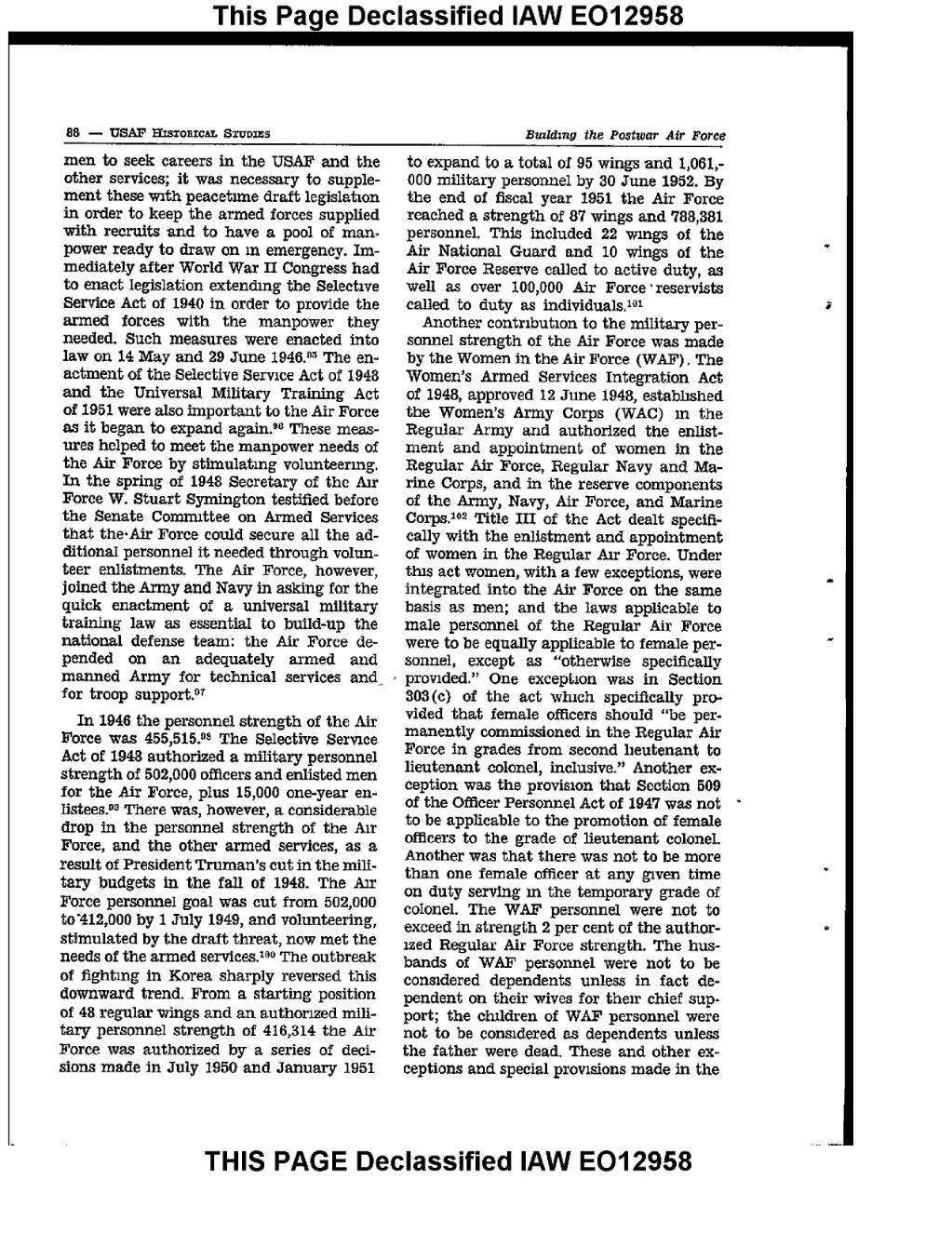�This Page Declassified lAW EO12958 Buzl?ng H?e Postwar Air Force men to seek careers in the USAIF and the other services; it was necessary to supple- ment these wuth peacetame draft legislahon in order to keep the armed forces supplied with recruits and to have a pool of man- power ready to draw on m emergency. Im- mediate!y after World War H Congress had to enact legislation extenchng the Select?ve Service Act of 1940 in order to provide the armed forces with the manpower they needed. Such measures were enacted into law on 14 May and 29 June I946. ?'? The en- actment of the Selective Semce Act of 1948 and the Universal Military Training Act of 1951 Were al?o important to the Air Force as it began to expand again2 ? These meas- ures helped to meet the manpower needs of the Air Force by stimulating volunteering. In the spring of 1948 Secretary of the A?r Force W. Stuart Symington testified before the Senate Corertattoo on Armed Services that the. Air Force could secure all the ad- ditionaI personnel it needed through volun- teer enlistments. The Air Force, however, joined the Army and Navy in asking for the quick enactment of a universal military training law as essential to build-up the national defense team: the Air Force de- pended on an adequately armed and manned Army for technical services and._ for troop support. o? In 1946 the personnel strength of the Air Force was 455,5152? The Selective Setwee Act of 1948 authorized a military personnel strength of 502,000 officers and enlisted men for the Air Force, plus 15,000 one-year en- iistees20 There was, however, a considerable drop in the personnel strength of the A?r Force, and the other armed services, as a result of President Truman's cut in the mili- tary budgets in the fall of 1948. The Ant Force personnel goal was cut from 502,000 to'412,000 by 1 July 1949, and volunteering, stimulated by the drrdt threat, now met the needs of the armed services. TM The outbreak of fighting in Korea sharply reversed this downward trend. From a starting position of 48 regular wings and art authorized mili- tary personnel strength of 416,314 the Air Force was authorized by a series of deci- sions made in July 1950 and January 1951 to expand to a total ol 95 wings and 1,061,- 000 military personnel by 30 June 1952. By the end of fiscal year 1951 the Air Force reached a strength of 87 wings and 78?,381 personnel. This included 22 wings of the Air National Guard and 10 wings of the Air Force Reserve called to active duty, as well as over 100,000 Air Force 'reservists cal?ed to duty as individuals. ?0? Another contrlbut?on to the military per- sonnel strength of the Air Force was made by the Women in the Air Force (WAF). The Women's Armed Services Integration Act of 1948, approved 12 June 1948, estabhshed the Women's Army Corps (WAC) m the Regular Army and authorized the enlist- merit and appointmen? of women in the Regular Air Force, Regular Navy and Ma- rine Corps, and in the reserve components of the Army, Navy, Air Force, and Marine Corps.?0e Title III of the Act dealt specifi- cally with the enlistment and appoh?tment of women in the Regular Air Force. Under trns act women, with a few exceptions, were integrated into the Air Force on the same basis as men; and the laws applicable to male personnel of the Regular Air Force were to be equally applicable to female per- sonnel, except as "otherwise specifically prowded." One exceptran was in Section 303(c) of the act ?vh?ch specifically pro- vided that female officers should "be per- manently commissioned in the Regular Air Force in grades from second heutenant to lieutenant colonel, inclusive." Another ex- ception was the provisxon that Section 509 of the Officer Personnel Act of 1947 was not to be applicable to the promotion of female officers to the grade of lieutenant colonel. Another was that there was not to be more than one female officer at any g?ven time on duty serving m the temporary grade of coIonel. The WAF personnel were not to exceed in strength 2 per cent of the author- ?zed Regular Air Force strength. The hus- bands of WAF personnel were not to be considered dependents unless in fact de- pendent on their wives for their chief sup- port; the children of WAF personnel were not to be conmdered as dependents unless the father were dead. These and other ex- ceptions and special prowsions made in the THIS PAGE Declassified lAW EO12958
